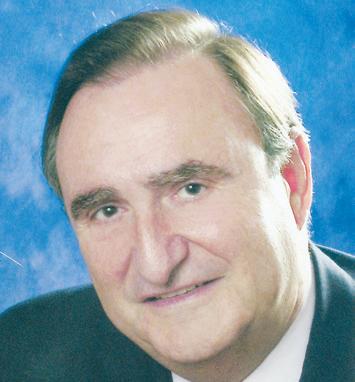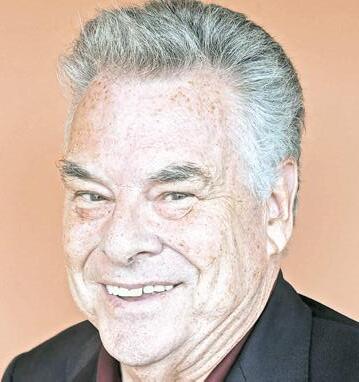Art exhibit is ‘Safe & Sexy’
Page 3
What’s new with George Santos?
Page 8
Celebrating Kerri Scanlon

Page 17

Art exhibit is ‘Safe & Sexy’
Page 3
What’s new with George Santos?
Page 8
Celebrating Kerri Scanlon

Page 17
 By WILL SHEELINE wsheeline@liherald.com
By WILL SHEELINE wsheeline@liherald.com


A lifelong athlete, Bjorklund has turned to writing and performing poetry and music as a way to keep his mind sharp and his spirits up.
Bjorklund prided himself on staying fit and healthy throughout his life. Only five months before he began developing
The former professional football player also played for North Shore High School in his youth.
Bjorklund played three seasons with the Jets from 1972 to 1974.
After leaving football, he studied law at Hofstra University and spent time with his family.
After putting professional
football behind him and working as a corporate lawyer, Bjorklund continued to stay active, hiking and traveling with his wife, Victoria.
In 2015, however, Bjorklund’s body began to fail him. His doc-

up and began writing poetry as a way to express himself and his emotions. Bjorklund said he enjoyed writing poetry back in high school, but hadn’t done so in decades.
“I just felt an urgency to write about my life, to try and make sense of the life I’ve had,” he
Glen Cove resident who immediately took a shine to Bjorklund and his wife.
Kandel said she was struck by how expressive and impressive Bjorklund’s work was, especially considering the fact that he hadn’t written anything like it CONTINUED
What’s new with George Santos?
Page 8
Celebrating Kerri Scanlon
Page 17
Rabbits are hopping their way back into Sea Cliff with the return of the Long Island Rabbit Rescue Group fundraiser on Saturday. The event raises money for Long Island’s largest volunteer rabbit rescue organization. The event is the Rescue Group’s first in-person fundraiser in Sea Cliff since the beginning of the coronavirus pandemic.
The group is made up of rabbit enthusiasts and owners from across Long Island, who address rabbit-related issues in their

ON PAGE 5

Former New York Jets running back Hank Bjorklund’s life changed forever in 2015, when he began experiencing health issues related to chronic traumatic encephalopathy, the brain disease associated with former football players.
A lifelong athlete, Bjorklund has turned to writing and performing poetry and music as a way to keep his mind sharp and his spirits up.
Bjorklund prided himself on staying fit and healthy throughout his life. Only five months before he began developing
health issues, his doctor told him he was in remarkable shape for a man of his age.
“There was a young cardiologist supervising my physical, and at the end of it she told me, ‘You’re average,’” Bjorklund recalled. “I was incredulous. I said, ‘Average?’ and she said, ‘Yes, average for a 20-year old.’”

The former professional football player also played for North Shore High School in his youth. Bjorklund played three seasons with the Jets from 1972 to 1974. After leaving football, he studied law at Hofstra University and spent time with his family.
After putting professional
football behind him and working as a corporate lawyer, Bjorklund continued to stay active, hiking and traveling with his wife, Victoria.
In 2015, however, Bjorklund’s body began to fail him. His doc-
tors told him that he was suffering from a degenerative neurological disease, which some identified as possibly being CTErelated due to his years playing football. Now wheelchair-bound, Bjorklund said he struggled with the diagnosis, feeling a sense of helplessness.
Until one day when he woke up and began writing poetry as a way to express himself and his emotions. Bjorklund said he enjoyed writing poetry back in high school, but hadn’t done so in decades.
“I just felt an urgency to write about my life, to try and make sense of the life I’ve had,” he
said. “I felt that I could get more in touch with those feelings through writing poetry.”
Bjorklund joined a local group that reads and discusses poetry, made up of residents in the North Shore School District and Glen Cove. The group was run by Nassau County’s former poet laureate, Evelyn Kandel, a Glen Cove resident who immediately took a shine to Bjorklund and his wife.

Kandel said she was struck by how expressive and impressive Bjorklund’s work was, especially considering the fact that he hadn’t written anything like it
CONTINUED ON
Ijust felt an urgency to write about my life, to try and make sense of the life I’ve had.
HANK BJORKLUND NSHS alumni
 By ROKSANA AMID ramid@liherald.com
By ROKSANA AMID ramid@liherald.com




Many on Long Island already are having a tough time finding affordable places to live. The elderly are priced out of affordable homes, and younger generations are fleeing to more affordable locales — many times out of state.
Lawmakers have tried a number of ways to keep rents low, but the latest plan offered by Gov. Kathy Hochul to build 800,000 new homes across the state over the next decade isn’t meeting with a lot of support. Especially on Long Island.
“We don’t want Hochul control, we want local control,” Hempstead Town Supervisor Don Clavin told a crowd of local elected leaders at the Port Washington Long Island Rail Road station earlier this month.

Clavin believes the governor’s proposal is a power grab and doesn’t take into consideration the differences between upstate and downstate communities. He worries Hochul’s plans will force Long Island to become the sixth borough of New York City.
While the proposal speaks to creating high-density housing, officials say it doesn’t address upgrading the existing infrastructure to accommodate the population increase — like roads and utilities. There also seems to be little attention from Albany about how such fast growth could impact schools, which might not be able to keep up.
Rents have risen 30 percent since 2015 in New York City, while home prices have grown 50 percent. The situation is even more dire outside the city where rents are up as much as 60 percent, with some existing home sales rising as high as 80 percent over the last eight years.
According to the Population Reference Bureau, more than half of the state’s renters are paying more than 30 percent of their income on rent, the second-highest rate
in the nation.
Hochul wants to battle that through what she’s calling the New York Housing Compact. It’s intended to eliminate many of the barriers stopping development of affordable housing — especially around Metropolitan Transportation Authority rail stations — including plans for the state to step in if local government refuse to act.
But that’s what really have many local leaders like

Clavin fired up. The town supervisor says Hochul’s proposal eliminates the public hearing process, and will allow an “unaccountable, bureaucratic board located hundreds of miles away in Albany to make decisions over what belongs in your neighborhood.”
The governor, however, believes the state’s housing crisis requires bold actions and an all-hands-on-deck approach.
“Every community in New York must do their part to encourage housing growth to move our state forward and keep our economy strong.” Hochul said, according to a release. “The New York Housing Compact is a comprehensive plan to spur the changes needed to create more housing, meet rising demand, and make our state a more equitable, stable and affordable place to live.”
The compact, however, suggests local leaders aren’t doing enough to address the housing crisis. And that’s wrong, said Jennifer DeSena, town supervisor for North Hempstead.
“We have a hearing process,” DeSena said. “There are always projects that are being considered Nassau County is the densest suburban community in the country. We have a lot of housing, and wanting to add an arbitrary number like 3 percent every three years, it’s just not realistic.”
Pamela Panzenbeck said she’s worried about a devastating scenario for the city she leads, Glen Cove, where giving the governor the power to rezone property within a half-mile from a train station to 50 units of housing per acre will hurt more than it will help.
The mayor also believes Long Island towns and cities should be able to decide for themselves what the appropriate land use is.
“Changes such as she suggests would destroy our way of life,” Panzenbeck said, “the historic nature and beauty of Glen Cove, and our Long Island communities.”
Sea Cliff was treated to a special exhibition presented by visual artist and photojournalist Sarah Hughes. Hosted by the Sea Cliff Arts Council, “Safe & Sexy” documents women from across the world, focusing especially on the themes of vulnerability, power, comfort and attraction.
Hughes, a Sea Cliff resident of six years, first began working on the project in 1999, while studying at the California College of Arts in San Francisco.
Hughes noticed that she often packed several different outfits with her when she went out, and would change her clothes to match the event or job she was going to.
She then did a social experiment where she asked people “Do you have the time?” wearing a different variety of outfits, from business suit to more revealing clothing such as jogging apparel.
“That’s really how the project started, from my own personal experiences,” Hughes said. “From there I decided to play around with that concept a bit, and I started photographing my friends in two different outfits; safe and sexy.”
Hughes initially started with her friends in San Francisco, where she found a stark difference in everything from their clothing to their body language and posture. After receiving a grant from the American Scandinavian Foundation, she moved to Sweden for several years, where she continued the project.
One of the things that struck her most from her work in Sweden was the difference in social norms regarding women’s appearances. Contrasted with the American subjects, the Swedish women she photographed dressed very similarly in both photos, which Hughes said emphasized the differences in gender equality between the two countries.

From there, the project continued to expand, with Hughes photographing women of all ages, identities
and backgrounds in as exotic locations as Brazil, South Africa, Swaziland and Turkey. Hughes found that what had begun as a social and artistic experiment developed into a discussion about politics, culture and society.
“I’ve always been interested in international relations and exploring various cultures,” Hughes explained. “I thought it would be interesting to look at the pretty significant shift in gender roles.”
The exhibit is up throughout March, and the walls of the Arts Council building are covered with contrasting photos of women in their safe and sexy outfits. In

addition to the photos, Hughes also recorded dozens of conversations with the women, which accompany the photos and provide background and explanations of the different outfits the women chose to wear, and why.
The Arts Council approached Hughes to ask her to hold an exhibit in the village. Mark Sobel, the Arts Council’s producer at large, said they were excited to have the opportunity to host such a thought-provoking exhibit.
“The concept is really amazing,” Sobel said. “Particularly since it’s Women’s History Month, we wanted to do it this month more than anything.”

Ithought it would be interesting to look at the pretty significant shift in gender roles.
SARAH HUGHES visual artist
Glenwood Glen Head Jr. Baseball
Since 1955
Fees:
This past September, Mayor Elena Villafane, along with Deputy Mayor Dina Epstein and Trustee Nicholas Pinto, the Board of Trustees, and village leadership launched a process to adopt Sea Cliff’s first Comprehensive Plan since 1970. Villafane initiated the process that includes every resident, committee and board across the village.
“This is a new day for Sea Cliff, and we need a comprehensive vision for the future of our village,” she said at the time, nicknaming the process, “Envision Sea Cliff, Reimagining Our Future Together.”
“When I took office, I pledged to my
Kindergarden : $100
Grades 1-7 : $175
Register at: www.gwghbaseball.org
Season: Late April - June
Registration must be completed by March 26th
For children born between 11/30/2009 and 12/01/2017 (Birth Certificates may be requested for first time registrants)
Parents interested in managing or coaching, please contact the League Office
For more Information, visit www.gwghbaseball org or call the League Office (516)757-4135
neighbors that Sea Cliff would undertake a serious, professional and most of all, inclusive comprehensive planning process to lay out a vision for the future of our village that reflects the voice of the residents,” Villafane said. “We are in the midst of this exhaustive planning process, and I want to emphasize to all residents, business owners, and organizations that you have the chance to make yourself heard on the future for Sea Cliff.”
The next public outreach session is on March 29, from 7 to 9 p.m. at St. Luke’s Parish Hall, 253 Glen Ave. All residents are urged to attend.
Nominations are now open for the Town of Oyster Bay’s 2023 Women of Distinction Program. At the start of Women’s History Month, residents are invited to nominate extraordinary women who have made a difference in their communities.
“If you know a special woman who helps make your community a better place to live, we invite you to nominate her to be a 2023 Town of Oyster Bay Woman of Distinction,” said Town Councilwoman Michele Johnson, who serves as chairwoman of the Women of Distinction Committee.

Town of Oyster Bay. To submit a nomination, visit oysterbaytown.com/women, or call (516) 624-6380.
Dr. Carol Ann Smyth was appointed full-time assistant superintendent for instruction by the North Shore Board of Education on March 9.
“Dr. Smyth is the best of the best and she raises the bar at the North Shore Schools,” David Ludmar, the board’s president, said.
The recent announcement by 98 year old Jimmy Carter, our long-lived president, that he was opting for hospice care at home instead of additional medical intervention, is in keeping with the trend towards dying with dignity. Hospice care arises when an illness is either no longer responding to medical treatment, no medical treatment is available, or the patient has decided they want to transition from treatments intended to prolong quantity of life to treatments intended to improve quality of life.
The recent announcement by 98 year old Jimmy Carter, our long-lived president, that he was opting for hospice care at home instead of additional medical intervention, is in keeping with the trend towards dying with dignity. Hospice care arises when an illness is either no longer responding to medical treatment, no medical treatment is available, or the patient has decided they want to transition from treatments intended to prolong quantity of life to treatments intended to improve quality of life.
One of the great misconceptions about hospice care is that it is the cessation of medical care. Dr. Sunita Puri, author of “That Good Night: Life and Medicine in the Eleventh Hour” defines hospice care as “intensive comfort-focused care, provided with the goal of minimizing the physical, emotional and spiritual suffering that patients and their families experience when somebody has possibly six months or less to live.” While hospice can usually take place at home it can also be in a facility and is paid for by Medicare Hospice Benefit.
One of the great misconceptions about hospice care is that it is the cessation of medical care. Dr. Sunita Puri, author of “That Good Night: Life and Medicine in the Eleventh Hour” defines hospice care as “intensive comfort-focused care, provided with the goal of minimizing the physical, emotional and spiritual suffering that patients and their families experience when somebody has possibly six months or less to live.” While hospice can usually take place at home it can also be in a facility and is paid for by Medicare Hospice Benefit.
The hospice “team” consists of (1) a nurse
The hospice “team” consists of (1) a nurse
to assess and manage pain and provide handson-care, (2) a social worker, to offer emotional support and help with planning, (3) a physician to interface with the patient’s primary physician and consult on pain and symptom management and make house calls, (4) a hospice aide to help with personal care needs, such as bathing, (5) clergy to offer spiritual support, (6) volunteers to help in a variety of ways, and (7) a bereavement specialist to provide grief and loss counseling.
to assess and manage pain and provide handson-care, (2) a social worker, to offer emotional support and help with planning, (3) a physician to interface with the patient’s primary physician and consult on pain and symptom management and make house calls, (4) a hospice aide to help with personal care needs, such as bathing, (5) clergy to offer spiritual support, (6) volunteers to help in a variety of ways, and (7) a bereavement specialist to provide grief and loss counseling.
“We are proud to recognize women in our town and invite residents to submit nominations of those who make a difference and enrich the lives of others,” Supervisor Joseph Saladino added. “We look forward to sharing their stories and recognizing their efforts to make our community, families and town a better place to live, work and raise a family.”
Women of Distinction will be recognized at an awards ceremony in May. Nominations may be submitted for any achievement or honorable cause performed by the nominee.
Since May 26, 2022, Smyth has served as the interim assistant superintendent for instruction. She has previously served in the district as the director of science K-12 and the director of elementary STEAM.
Regrettably, hospice care in the US averages only about three weeks, due to the fact that people are reluctant to talk about topics like suffering, quality of life and whether treatments are adding to or detracting from someone’s quality of life. Delaying those conversations leads to very late referrals to hospice.
Regrettably, hospice care in the US averages only about three weeks, due to the fact that people are reluctant to talk about topics like suffering, quality of life and whether treatments are adding to or detracting from someone’s quality of life. Delaying those conversations leads to very late referrals to hospice.

Honorees must live or work in the
“It is an honor to work at the North Shore schools,” Smyth said. “We have amazing students, committed parents, incredibly talented educators, and a dedicated staff. We are a unique learning community committed to honoring tradition and pursuing continuous growth and innovation such that all our students can discover and follow their dreams.”
As Dr. Puri points out, “Hospice is not about giving up...hospice is about acknowledging where your body is at, at a given stage of illness, and honoring that and honoring the person that you are, which is distinct from the illness you are suffering...hospice attempts to maximize dignity and minimize suffering.”
As Dr. Puri points out, “Hospice is not about giving up...hospice is about acknowledging where your body is at, at a given stage of illness, and honoring that and honoring the person that you are, which is distinct from the illness you are suffering...hospice attempts to maximize dignity and minimize suffering.”
■ WEB SITES: seacliff.liherald.com glenhead.liherald.com
■ E-MAIl: Letters and other submissions: seacliffeditor@liherald.com, glenheadeditor@liherald.com
■ EDITORIAl DEPARTMENT: Ext. 327 E-mails: seacliffeditor@liherald.com, glenheadeditor@liherald.com
■ SUBSCRIPTIONS: Press ”7” E-mail: circ@liherald.com Fax: (516) 569-4942
■ ClASSIFIED ADVERTISING: Ext. 286 E-mail: ereynolds@liherald.com Fax: (516) 622-7460
■ DISPlAY ADVERTISING: Ext. 249 E-mail: rglickman@liherald.com Fax: (516) 569-4643
communities.
Mary Anne Maier, the group’s co-founder and a Sea Cliff resident, said the volunteer organization gets 30 to 60 calls a month about a variety of problems, from owners with sick pets to locating homes for abandoned rabbits.
One of the most heartbreaking problems they deal with is finding and saving abandoned pet rabbits left to fend for themselves in the wild. Maier said domesticated rabbits have no survival instincts after a lifetime in captivity. Her group have found and rescued over 1,000 homeless rabbits last year.
“That’s the big problem that no one knows about because they don’t bark and they’re under the radar once they’re on the street,” Maier said. “It’s kind of a different scene from cat and dog rescue in that it’s like this quiet little epidemic.”
the directions to help my own rabbit, and it’s one of their biggest fundraisers of the year.”
The event leans heavily toward an Easter Bunny theme with the fundraiser traditionally held the week before Easter Sunday. This year it’s being held earlier, on Saturday.
The Easter Bunny will make an appearance providing children and adults with an opportunity to take photos. Attendees can also purchase T-shirts and tote bags with the Easter Bunny image.
Saturday, March 18

1 to 4 p.m.
Still Partners
225 Sea Cliff Ave., Sea Cliff
The group began holding its fundraiser in 2015, thanks in large part to the efforts of another Sea Cliff resident and rabbit-owner, Mark Hagan. He first became aware of the group after a chance encounter with Maier, where he discussed the health issues of his beloved pet rabbit, Lucy.
Maier helped Hagan get in contact with her veterinarian to address Lucy’s health concerns. Hagan expressed his gratitude by recruiting friends to put together the group’s first major fundraiser event at Still Partners in Sea Cliff, the home of the event every year since.
“It’s an educational event to encourage adoption under the right conditions and discourage impulse buying,” Hagan said. “This is really my thank you for giving
The group also brings several “ambassador bunnies” with them to the event — rescued rabbits acclimated to handle larger crowds. While attendees won’t be able to hold or pick up the rabbits, they will have the opportunity to pet them to their hearts’ content.

“We have to make sure that we’re going to bring only what we call our ‘bombproof bunnies’ to the event,” Maier explained, “rabbits who will be comfortable and not panic and either get sick or injure themselves by being afraid.”
Additionally, there will be a raffle featuring both rabbit-themed prizes such as giant chocolate Easter Bunnies, bottles of wine or paintings. Hagan said that most of the gifts are donated by different businesses and community members, such as the Onion Tree, Country Club Florist and Brooklyn-based chocolaterie Jacques Torres Chocolates.
All money raised goes towards supporting the Rescue Group. Hagan said that previous fundraising events, made as much as $6,000 for the group. He plans to match at least half of the total raised, which he has done at
Sands brings the worlds of fine dining, exhilarating entertainment and spectacular architecture together in an opulent package. Extravagance leads every step of our process. From our commitment to wholistic spa experiences to lavish in-room amenities, from celebrity chefs in our restaurants to celebrities on the stage, Sands leaves nothing to the imagination!
every fundraiser in the past.
Maier and Hagan both mentioned how excited they were to be holding the fundraiser after a three-year hiatus, and they expect the fundraiser to be as fun for the community as it is essential to the Rescue Group.

For weeks, the ideal stage had been set for the full launch of Grand Central Madison, finally connecting the Long Island Rail Road to the bedrock of Midtown Manhattan.
Or so it seemed.
Limited shuttle service between Jamaica station and Grand Central Madison gave commuters roughly four weeks to try out the new travel routes in advance of the big day, warming them to the idea of the $11 billion East Side terminal.
But as the new service rolled out, some reinforced their concerns. While a number of service lines have been expanded, others have been completely rescheduled. And there were those who worried about inadequate direct service to Penn Station and Atlantic Terminal after timed connections would be eliminated at the Queens station, as well as through direct transfers across platforms at stops like Jamaica under the new schedules.
Then, full-service started Feb. 27, and contrary to the MTA’s calculated expectations, the ensuing first days of its historic Midtown terminal turned into the most dizzying and distressful for commuters in recent memory.
Riders — coping with the rush-hour meltdowns at Jamaica station and onboard Penn Station-bound trains — poured their anger and disbelief onto social media. Images and posts showed commuters cramming into train aisles. Others making frantic sprints to catch their connecting lines. And many finding themselves tightly jammed inside an antsy crowd of riders on waiting platforms.
By the end of the first week, MTA officials rushed to provide relief in the form of extra train cars added to roughly 30 of its busiest trains, most of them rush hour excursions on the Penn Station service routes, as well as ramping up the frequency of shuttle service between Brooklyn and Queens.
While the adjustments have managed to ease overcrowding and quell a frantic commuter flow, the fumbled full launch of Grand Central Madison has left some commuters scratching their heads — and shaking their fists — at what went wrong.
The reason, according to Long Island Rail Road interim president Catherine Rinaldi, can be chalked up to a miscalculation on how many commuters would actually shift from Penn Station to Grand Central.
The LIRR’s original service plan was designed to accommodate a “60-40” split of ridership, with most still traveling to Penn Station. So far, however, the split has been more “70-30,” although new ridership figures are still pending.
For all the initial bumps, however, Barry Kleinworm — a diamond inventory manager in Midtown Manhattan — said full service to the East Side was a “home run” decision.
“Grand Central station is only five minutes from my office, so I’m loving it,” the Woodmere commuter said. “Before, I had to walk 20 minutes from Penn Station. So this is a benefit for me for sure.”
It’s something that should have happened 30 years ago, said Jack Halpern, who rides the Far Rockaway branch.
“I’m a lawyer, and my office is in the Grand Central area,” he said. “But of course, I don’t go all the time what with hybrid work. It would have been really helpful to have this service pre-Covid when I was going five days a week.”
Despite the benefits, however, Halpern did note that finding his way in and out of Grand Central has proven difficult.
“When exiting the station, going up the escalators is ridiculous, so I use the elevators. But they’re not all in the same area,” he said. “Entering the station, there is no clear signage on the street level to point you to what looks like a temporary construction elevator that takes you
down into the station, so they have to make the signage a little clearer.”
Melvin Medina says commuting on the Babylon branch is “not so bad,” but feels the benefits tilt toward Grand Central commuters at the expense of everyone else.
“There used to be an express train straight to Penn Station,” the commuter from Bay Shore said. “Now, by around 8 a.m., I have to transfer to Wantagh to get to Penn, and the train stops at every stop.
“At the end of the day, you’ve just got to plan ahead. But I don’t really agree with all the changes made.”
Then there are commuters like Debby Washington who say navigating the new train schedule changes has been nothing but daily stress.
“I hate it. It’s just so much confusion going on,” the Wantagh commuter said. “It’s just not organized right now. The schedule is crazy, and the trains come out of nowhere with no announcements.
“I’m paying a lot of money in taxes, and my service is not that great. In fact, it’s getting worse.”
But a lot of that might simply be a resistance to change, based on long-term familiarity to what’s already been in place — even if what’s there now wasn’t all that great.
“I think people are used to what they had before, and so if you’ve been commuting to Penn Station for decades, it definitely throws a wrench in your regular routine,” said Amy Zervas of Merrick. “I travel to both stations, but I prefer Grand Central because there are fewer people on those trains. Either way, I’ve had no issues.”
While opinions appear sharply divided, Rinaldi reassured commuters that changes are being made as needed.
“We are going to be continuously making adjustments based upon ridership and loading data. We look at it every single day,” she said. “The Long Island Rail Road team is all over the rollout in terms of looking for trends, what ridership is looking like, what trains are popular, and adjusting accordingly.”
“Clearly the opening of Grand Central Madison is a benefit, but my office has received numerous complaints regarding schedule changes, specifically additional travel time for our commuters on the West Hempstead line where riders at Malverne and Westwood now experience an approximate hour gap in travel times from the old schedule.
Sen. Patricia Canzoneri-Fitzpatrick and myself were informed that the Long Island Rail Road would reevaluate scheduling times for the West Hempstead line if data was provided regarding commuters’ preferred changes. We decided to hand out voluntary surveys to commuters about the issue.”
Assemblyman Charles Levine
“We have all known for years that the Oyster Bay line is the Metropolitan Transportation Authority’s biggest loss leader. With the advent of East Side Access, the MTA has had to reroute and reprogram any number of trains from the Oyster Bay line. The biggest challenge is that the OB line runs on diesel-powered trains that need to stop at Mineola where there is a transfer for riders to get on electric trains to go into the city.
We do not have express trains running directly into Penn Station as we had in the past before the new train schedules. The result is there is less availability for Oyster Bay commuters to travel than there was before, and riders are not pleased — nor should they be pleased. I’m confident, however, that the MTA leadership is aware of this issue and will be addressing it.”
NORTHWELL’S NATIONALLY ACCLAIMED DOCTORS DELIVER COMPLEX, SPECIALIZED SERVICES RIGHT HERE AT GLEN COVE HOSPITAL.
With head & neck surgery, robotic surgery, breast reconstruction and more, our experts are providing sophisticated care at its absolute best. And through it all, our warm, neighborly approach to care remains. Raise your expectations of what your community's hospital can be.
See what's new at Northwell.edu/AdvancedCare
since he was a teenager. She was moved, she said, when reading and listening to his poetry, as his work tackled themes such as loss and endurance in the face of tragedy.
“Hank had spent his whole life as an athlete and a lawyer, and yet his work was already fully developed,” Kandel said. “He really is an amazing poet.”
Through this group and other poetry groups, Bjorklund got to know fellow poetry-enthusiasts, Diane Menzel and Helen Kotzky, both of Glen Cove. In addition to writing poetry, the two are also musicians who play together at small local venues.
Moved by Bjorklund’s story, the two women began working with him to turn his poems into music. Bjorklund said that his poetic style was inspired in part by the works of Leonard Cohen, so the transition wasn’t difficult.
The two musicians explained that they work with Hank to find different ways to adapt the poetry to song. Menzel typically creates the melodies, while Kotzky devel-
ops the harmonies, and they play accompaniment and background to Bjorklund’s singing during live performances.
“Working with Hank is a very interesting dynamic,” Menzel said. “He uses poetry to deal with some of his anxieties and fears and sadness, and then he gives the lyrics to us.”
“It’s inspiring and fun and fulfilling, and I think we’ve seen him grow stronger throughout the process,” Kotzky added. “He’s a lovely person, very humble and grateful that this all came together the way it did.”
Bjorklund, Kotzky and Menzel played two concerts at the Sea Cliff Arts Council’s building on March 4 and 5. The room was packed with guests, and according to Mark Sobel, the Council’s producer at large, Bjorklund’s poetic words moved the audience.

“You hear and see what he’s going through with his affliction, and to see what he’s done to overcome it is just amazing,” Sobel said. “Poetry is a healer, and it helps people dealing with difficult situations overcome them.”
Like many new congressional members, George Santos is looking to get his name on key pieces of legislation in front of the U.S. House of Representatives — the higher profile the better.
But unlike other congressional members, Santos is falling short. Even with members of his own New York Republican delegation.
Santos sought — and failed — to be included in two legislative proposals offered by fellow Nassau County U.S. Rep. Anthony D’Esposito aimed to prevent House members convicted of financial or campaign fraud from profiting off such federal violations and fabrications.

If passed, the No Fame for Fraud Resolution would change rules governing the House, intending to ensure current members indicted for violations of the Federal Election Act of 1971 or any other offenses — which would cause them to lose their congressional pension — cannot financially profit off their story.
The second part of the package is the No Fortune for Fraud Act, intended to guarantee any current or former House members found guilty of violating the Federal Election Act of 1971 or other laws cannot make money off their story and will lose their pension.
These profits include compensation for biographies, media appearances or other creative works.
“I am committed to advancing good, accountable government here in our nation’s capital, and that includes preventing elected officials who broke the public’s trust from profiting from their misdeeds,” D’Esposito said, in a release. “Con artists, liars and fabulists who lied their way into Congress should not be able to monetize their lies, and this legislative package would ensure they are unable to do so.”
The congressman didn’t call out Santos by name, but Santos has been accused of lying about his past — including schooling, work history, and even his family. He is currently under a number of investigations — primarily for campaign fundraising — but has resisted calls to resign. Even from members of his own party.
The former New York Police Department detective said after spending a majority of his career “keeping criminals off the streets of New York,” he hopes to “keep fraudsters out of the halls of Congress” with this new legislation.
Surprisingly, Santos told NBC News he believed D’Esposito’s proposal was a “good bill” about “good
governance.” Santos has introduced a bill of his own directly affecting elected officials, with his aimed squarely at the President of the United States. His bill demands mental competence examinations as part of the presidential qualification process.
Santos recently sat down with British tabloid journalist Piers Morgan and admitted to lying about attending Baruch College. He even apologized. But he didn’t admit to much else, except that he’s a “terrible liar.”
The congressman also faces several complaints from the Federal Election Commission regarding his campaign finances, contributions and fundraising methods. Last month, Santos named Andrew Olson as his new treasurer after the FEC warned he could not raise or spend money without one. Then, earlier this week, Santos announced his intention to seek re-election — a move that was required of him to help keep his latest fundraising up-to-date.
The House Ethics Committee created a subcommittee to investigate Santos, and if they discover he has broken any laws, it could call for his expulsion.
Joining D’Esposito on his bill are Republicans Nick LaLota, Brandon Williams, Mike Lawler, Marc Molinaro and Nick Langworthy. D’Esposito has openly called for Santos to step down from office, as well as many of his GOP colleagues.
LaLota said no House member, regardless of what side of the aisle they stand on, should be able to “profit off their crimes, lies, indictments or fraud.”
“Liars and cheats should not reap any reward from their deception,” LaLota said, in a release. “I ran on restoring transparency and accountability to our government because I believe that our constituents should be able to trust their representatives and know that we are fighting for them every day — helping make our country a better, safer, and more prosperous place. Not trying to land a deal with Netflix.”

Headaches are the worst. They come at the worst time, but can be treatable with a pop of Tylenol or Advil. But have you ever asked yourself if it could be something more?
If it is, knowing when to seek medical attention is what those who tuned in to the recent Herald Inside LI webinar were looking for as Dr. Kimon Bekelis shared his expertise on the critical differences between a brain aneurysm and a stroke — and how to treat or prevent either one.
A brain aneurysm is a weak spot in the blood vessel in the brain that can burst. An estimated 30,000 people in the United States suffer a brain aneurysm rupture each year, according to the Brain Aneurysm Foundation.
“Because it’s a fairly rare disease,” Bekelis said, “I think it hasn’t been as mainstream.”
Symptoms of a brain aneurysm can be confused with a headache. If it’s allowed to rupture, it could mean everything from brain damage, to coma, or even death.
Bekelis is a certified neurosurgeon with training in invasive endovascular neurosurgery. He is also the chairman of neuro-interventional services for Catholic Health Services of Long Island, and co-director of the Neuro Intensive Care Unit at Good Samaritan Hospital.
He’s also the director of the Stroke & Brain Aneurysm Center of Long Island, located in Babylon. With all that experience, if Bekelis comes across someone with a stiff neck, blurred or double vision and confusion, he knows he needs to take action right away. The feeling of an aneurysm is like someone hitting you with a hammer.
“It is a very severe event when they rupture,” Bekelis
said. “But people do survive.”
Preventing an aneurysm varies from not smoking or using tobacco products, having a healthy diet, and checking your blood pressure and exercising regularly.
But if worrying about aneurysms aren’t enough, Bekelis also warns about strokes. They are caused when blood supply is blocked in part of the brain, or when a blood vessel bursts.
More than 795,000 people in the United States suffer a stroke each year, according to the Centers for Disease Control and Prevention.
“Detecting and identifying a stroke fast is the most

important factor in guaranteeing that somebody is not going to have a deficit,” Bekelis said
The American Heart Association created an acronym it believes will help determine if someone is having a stroke. “FAST” is short for face drooping, arm weakness, speech difficulty, and time to call 911.
The “deficit” of a stroke can vary from impaired speech, limited physical abilities, weakness or limb paralysis. But just like aneurysms, there are ways to prevent strokes, Bekelis said.
Monitor blood pressure and cholesterol. Cut cigarettes. Monitor weight. And, of course, exercise. And there could also be a “magic” pill that might help, too.
“When it comes to aspirin, it used to be a general recommendation that if you’re over the age of 55, they would put you on a baby aspirin,” Bekelis said. “Nowadays, it’s been modified a little because aspirin has been founded to slightly increase the risk of bleeding if you don’t have any risk factors.”
Thinner blood might be good for strokes, but could be bad for other conditions. So, adding a baby aspirin regimen is something Bekelis says should be monitored by a doctor.
It’s challenging to know what the brain is trying to tell us in a headache. But when you know something doesn’t seem right, Bekelis says it will be hard to miss.
“When it comes to a stroke, the symptoms — you can’t miss them,” the neurologist said. “When it comes to a headache, things are a little bit more murky, and headache is a symptom of aneurysm rupture possibility.
“An aneurysm headache is like the worst headache of your life. If it’s one of those, seek immediate medical attention.”
LIJ Medical Center is in the top 10% of hospitals nationally for oncology, according to U.S.News&WorldReport. Northwell.edu/NoLimits
Our doctors are raising health by pioneering innovative approaches to cancer from novel chemotherapy techniques to first-in-the-nation robotic mastectomies with minimal scarring. Because when it comes to cancer, there’s no status quo. There’s only “how far can we go?”

Since the invention of the camera, photographers have been enthralled by interpreting the natural world. We (viewers), in turn, are captivated by what their cameras reveal.
A true Broadway legend returns her Long Island roots, visiting Tilles Center with her acclaimed one-woman show. ‘Don’t Monkey with Broadway’ is a celebration of her life-long love affair with Broadway, as she indelibly interprets classic theatre tunes by the likes of Richard Rodgers, Lorenz Hart, Jule Styne, Stephen Schwartz, Charles Strouse, Leonard Bernstein, Stephen Sondheim, Cole Porter, and Irving Berlin. She explores her love affair with Broadway and offers up her opinion and concerns for what the Great White Way is becoming today, in this intimate concert, which includes behind-thescenes anecdotes.
Sunday, March 19, 7 p.m. $110, $75, $55. Tilles Center for the Performing Arts, LIU Post campus, 720 Northern Blvd., Brookville. (516) 299-3100 or TillesCenter.org.
As we spring forward, we’re all eager to enjoy the landscape as it emerges from its winter “hibernation.”
It’s the subject of Heckscher Museum of Art’s current exhibition, “Viewfinders: Photographers Frame Nature,” on display through April 16.
Viewfinders explores artists’s varied responses to the relationship between nature and humans. These lens-based works reveal the divergent ways in which nature continues to fuel documentation of the human experience and imagination — from images symbolizing the untamed power of nature, to those where the landscape has been abused for human consumption. The exhibit — featuring 64 works from 34 artists — traces the lure of photography through the centuries, culminating in contemporary times where every person with a smartphone has the power to “frame” nature.
Guest Curator Susan Van Scoy, associate professor of art history at St. Joseph’s University, combed through the museum’s permanent collection to explore the myriad ways artists respond to the landscape and how their responses have shaped our perception of nature.
By Karen Bloompeople shape the future of the environment and change our behaviors.”
Visitors will notice a “local flavor” to the exhibit, such as N. Jay Jaffee’s photo of Lloyd Harbor’s Caumsett Park Preserve.
As Van Scoy explains: “The Olmsted family landscape architectural firm created some of the most famous and unnatural ‘natural’ sites in the world, including New York City’s Central Park and Caumsett State Historic Park Preserve. Yet some visitors view these parks as nature in its untouched state. Caumsett State Historic Park Preserve has been a favorite subject of artists such as Jaffee and Neil Scholl, whose photographs capture the landscape architects’s signature picturesque landscapes in the park.


• Now through April 16
• Open Thursday through Sunday, noon-5 p.m.
• Saturday and Sunday, noon-4 p.m.; Tuesday through Friday, 11 a.m.-4 p.m.
“Visitors just love the Caumsett shot,” she says. “Many people don’t realize its history.”
• $5 suggested admission non-members; members and children younger than 13 free
• Heckscher Museum of Art,
• Emily Lowe Hall Gallery, South Campus, Hempstead. For information and to RSVP, call (516) 463-5672, or visit Hofstra.edu/museum

2 Prime Ave., Huntington (631) 380-3230 or Heckscher.org
Stand,” Hofstra University Museum of Art’s new exhibition, examines power of the arts in society.
Alexandra Giordano — the museum’s assistant director of exhibition and exhibit underscores artists’ civic responsibility and influence. the vital role that artists have in activating democratic values that and freedom, encouraging civic engagement, and cultivating unity,” “Artists often lead the charge and expose truths that may otherwise be artists in this exhibition take a stand and call out injustices through their art issues such as immigration, gender, reproductive rights, mass incarceration, bias, gun violence, and promises unfulfilled. They all combine the making service that has a grassroots approach in the hope of mobilizing their the nation to ignite movement, create awareness, and inspire others to which runs through July 28, is in conjunction with Hofstra’s conference on the Barack Obama presidency coming up in April. interested in the idea that the artist has a civic responsibility,” says Karen
“Landscape and photography have always been closely intertwined. In fact, the world’s first automatic photograph was a landscape and photography was first referred to as ‘sun pictures’ or ‘drawings from nature,’” Van Scoy says. “Artists have long used landscape as a vehicle to explore other issues such as poetry, spirituality, philosophy and environmentalism. The images in are no exception. They are teeming with hidden meaning.“
Legendary American photographers such as Edward Steichen, Larry Fink and Berenice Abbott are represented, as are newly acquired photographs by Kenji Nakahashi and Jeremy Dennis. Van Scoy also selected a substantial number of works by notable Long Island image makers.
Beyond traditional forms of landscape photography, Van Scoy was excited to introduce what she describes as the “contemporary takes,” which explore environmental issues such as climate change and reclaiming the land.
“Everyone enjoys seeing landscape, now it’s being used as a background for protest,” she says. “Artists have an important role to help
Picturesque scenes are just one aspect of what’s on view. From the whimsical — such as Barbara Roux’s mise-en-scènes in wooded areas with frames or mirrors placed against a leafy ground, to natural images that show the power of nature in Kenji Nakahashi’s abstract take on Hurricane Gloria — nature in all its forms is documented.
“I want people to be able to look at these works and relate to them,” she says. “I love when you can relate an image to your everyday life and also learn something new at the same time.”
The takeaway from Van Scoy: “We are reminded that humans are always small in relationship to the power of nature.”
Pat McGann is quickly rising as one of the sharpest stand-ups on the comedy scene. A relative latecomer to comedy, he began doing standup at 31 after realizing he was not very good at selling packaging. He hustled his way to become the house emcee at Zanies Chicago, where he distinguished himself as especially adept at working the crowd. A husband and father of three young children, McGann’s appeal stems from his quick wit and relatable take on family life and marriage. In 2017, McGann began touring as the opening act for Sebastian Maniscalco, moving with him from clubs to theater, to arenas, including four soldout shows at Madison Square Garden. McGann’s relatively short, but impressive resume, includes Montreal’s famed Just For Laughs Festival, Gilda’s LaughFest, The Great American Comedy Festival, and more. McGann still calls Chicago home.
Top left: N. Jay Jaffee’s Long Island Sound from Caumsett (1990) — a gift of Paula W. Hackeling — is an example of landscape photography that follows a formula used in early 17th century paintings.

Saturday, Feb. 11, 8 p.m. $40, $35, $30, $25. The Paramount, 370 New York Ave., Huntington. (800) 745-3000 or Ticketmaster.com or ParamountNY.com.
Top right: Barbara Roux’s Night Rises Up (1998) merges the subjective individual with the natural world.
Bottom: Kenji Nakahashi’s Decoration for Hurricane Gloria (1985) reflects nature’s untamed power.
The singer-songwriter comes to the Landmark on Main Street stage for an exciting evening of roots rock, with special guest James Maddock. Nestled somewhere between power-pop and American folk, you will find Willie Nile strumming his guitar. A true believer in rock ‘n’ roll, over the years Nile has made admirers out of such names as Bruce Springsteen and Pete Townshend who personally requested him to tour with The Who, among others who sing his praises. The New York Times called him ‘one of the most gifted singer-songwriters to emerge from the New York scene in years,’ among the many accolades he has received. The timeless qualities of melodic craft, lyrical insight and emotional engagement that have endeared Nile to listeners around the world throughout a three-anda-half-decade recording career continue to be prominent in his live performances.
Saturday, April 1, 8 p.m. $30, $25. Jeanne Rimsky Theater at Landmark on Main Street, 232 Main St., Port Washington. (516) 767-6444 or LandmarkOnMainStreet.org.
change the world?
been at the focus of our collective centuries. Now as society
the complexities of modern life, path for social change is at the of artistic expression.Courtesy Heckscher Museum of Art
Oyster Bay Town Clerk Richard LaMarca’s office holds a special one-stop Passport Weekend, Saturday and Sunday, March 18-19, 9 a.m. to 3 p.m., at Town Hall North, 54 Audrey Ave., Oyster Bay. For more information or to schedule an appointment, call (516) 6246324.
Enjoy visiting friends, with a delicious lunch and chair yoga, at the popular senior program hosted by Mutual Concerns, every Tuesday, at Saint Luke’s Episcopal Church, at 253 Glen Ave., in Sea Clifff. Those iinterested in joining the lunch program can call Peggie Como at (516) 675-7239.
Explore the fascinating history of whaling, Saturday, April 1, 11:30 a.m. or 12:30 p.m., at The Whaling Museum & Education Center. Examine the museum’s whaleboat, touch a harpoon and more, during the drop-in chat, 301 Main Street, in Cold Spring Harbor. For information, visit CSHWhalingMuseum.org.
The 10-time Grammy winning vocal group celebrates their 50th anniversary, performing at The Space, Thursday, March 30, 8 p.m. The group looks back on a career that has spanned genres from pop to jazz to rock and roll and more, in this special evening that highlights their long and dazzling career with their signature pitchperfect vocals and impeccable style. Tickets are $65-$175; available at Ticketmaster.com or TheSpaceAtWestbury.com. The Space, 250 Post Ave. Westbury.
Mo Willems’ popular The Pigeon comes alive on the Long Island Children’s Museum stage, Friday March 17, 10:15 a.m. and noon; Sunday, March 19, noon. Pigeon is eager to try anything. LICM, Museum Row, Garden City. (516) 224-5800 or LICM.org.

Items on The Scene page are listed free of charge. The Herald welcomes listings of upcoming events, community meetings and items of public interest. All submissions should include date, time and location of the event, cost, and a contact name and phone number. Submissions can be emailed to thescene@liherald.com.
Examine work of trailblazing female photographers Mattie Edwards Hewitt and Frances Benjamin Johnston, Saturday, March 25, 11:30 a.m. to 2 p.m., at Planting Fields Arboretum. Join author Bettina Berch for a lunch-lecture, at 1395 Planting Fields Road, Oyster Bay. For more information, visit PlantingFields.org.
The Woman’s Club of Glen Cove hosts its monthly luncheon, Tuesday, March 21, 11:30 a.m. The philanthropic club, which raises and distributes funds to charities in Glen Cove, meets at the View Grille, 111 Lattingtown Road, in Glen Cove. For further information on becoming a member, text Yvette Menezes at (516) 673-1061.
Plaza Theatrical is ready to spring forward with “Forever Plaid,” an affectionate musical homage to the close harmony guy groups that reached the height of their popularity during the ‘50s, Saturday, March 18, 7:30 p.m.; Sunday, March 19, 2:30 p.m.; Thursday, March 23, 2 p.m. The show features such hits as “Three Coins in a Fountain,” “Heart and Soul,” “Catch a Falling Star,” and “Love is A Many Splendored Thing.” It’s performed at Plaza’s stage at the Elmont Library Theatre, 700 Hempstead Tpke., Elmont. $49, $45 seniors. Elmont. For tickets, call (516) 599-6870 or visit PlazaTheatrical.com.

Everyone’s favorite cat comes to mischievous life in this theatrical adaptation of the Dr. Seuss classic, presented Plaza Theatrical Productions, Sunday, March 19, noon. See what goes on during that rainy day when two siblings are home alone with their pet fish while their parents are out of town, and the tall cat wearing a hat appears. Tickets are $15. Visit the Plaza stage at The Showplace at Bellmore Movies, 222 Pettit Avenue, Bellmore. For information/tickets, go to PlazaTheatrical.com or call (516) 599-6870.

















Explore the history of the notorious female pirates such as Anne Bonney and Mary Read and decide whether they were rogues, she-devils or trailblazers, Saturday, March 25 at 2 p.m., at North Shore Historical Museum. 140 Glen Cove St., Glen Cove, For more information, call (516) 8011191.







Glen Cove Public Library offers a virtual presentation on Irish genealogy. This session will explore the sites of the major repositories and principal archives in Ireland. To register visit GlenCoveLibrary.org. For more information contact Lydia Wen at at (516) 6762130, ext. 132, or LWen@ glencovelibrary.org.










































































































































Jazz giant Dave Brubeck’s sons celebrate their dad’s life and career, with “The Brubeck Brothers Quartet Celebrates Dave Brubeck’s Centennial,” on the Tilles Center stage, Thursday, April 13, 7:30 p.m. Chris and Dan Brubeck bring their multimedia show to the LIU Post campus, 720 Northern Boulevard, Brookville. To honor Brubeck’s legacy, the Brubecks, who performed and recorded with their father since the 1970s, curate this memorable concert with their own Brubeck Brothers Quartet. Through their stories, with music performed by the quartet, the show invites audiences to travel along the timeline of Brubeck’s extraordinary life and career. Tickets are $52; available at TillesCenter.org or (516) 299-3100.

















































Enjoy lively tunes with the Johnny Mac Band, Saturday, March 25, starting at 8 p.m., at Still Partners. The band is known for their spicy rhythm and blues, phat funk and hot jams, 225 Sea Cliff Ave., Sea Cliff. Visit StillPartners.com for information.












































































Mercy Hospital offers a peer to peer meeting for breastfeeding support and resources, facilitated by a certified breastfeeding counselor, every Thursday, 10:30 a.m.–11:30 a.m. Bring your baby (from newborn to 1 year) to the informal group setting. All new moms are welcome, regardless of delivering hospital. Registration required. Call breastfeeding counselor, Gabriella Gennaro, at (516) 705-2434 to secure you and your baby’s spot. Mercy Hospital, St. Anne’s Building, 1000 North Village Ave., Rockville Centre. For information visit CHSLI.org.





 By ANDRE SILVA asilva@liherald.com
By ANDRE SILVA asilva@liherald.com




It had to be done, and they did it. Nassau Community College’s board of trustees made a plan to increase health care premiums for its faculty and staff official — something the employees union that has spent months negotiating a new contract says could effectively reduce salaries by as much as $5,000.
The new insurance premiums begin March 23, and simply reflect a cost increase by their carrier, NCC officials said. They were allowed to pass on the increase despite a lack of a new contract based on a past agreement that allowed the board to make such increases under an expired contract.





The insurance increases, according to union president Faren Siminoff, could effectively act like a pay cut.


“These are the actions of people with no soul,” Siminoff said. “The college was asked by Nassau County if they needed more funding, and the college told them they do not need supplemental income. Instead the college decided to bleed its faculty dry.”
The educators union and trustees board has been negotiating full-time faculty contracts since last July, hoping to work out a deal before their contracts expired a month later. The union has rallied multiple times since then, but there is still no new contract on the table between NCC and its full-time faculty.

NCC attorney John Gross said the imposed health care provisions were not “pulled out of thin air.” In fact, the union knew about the existing contract provision, which was negotiated decades ago.

“The college board is a public agency, and they have a fiduciary responsibility to effectuate what’s in the contract,” Gross said. “If the (college board) said no to this (imposing health care premiums), they would be giving up thousands and thousands of dollars.”

This time around, the union is entertaining a proposal for new employees to pay about 20 percent of health care premiums, and existing staff members are willing to give roughly 2 percent of their salary toward the cost of premiums during their last negotiation sessions.
But the college has known health care premiums were rising since last December, Siminoff said, and that those costs would be passed along to employees. So why did the school wait until after the new year to notify faculty members of the change, during the open enrollment period?
“Usually in November or December, if you have an insurance policy through your job, you’re permitted to change your policy,” Siminoff said. “So, while most of us
























CoLLEgE’S board of trustees announced their intention to impose health care premiums on staff members, effectively reducing salaries by $5,000 on average, according to the union representing fulltime faculties, who say it’s a negotiation tactic.
are the college’s plan, there are many faculty members who could be covered under a partner’s plan. In order for them to switch coverage plans, they have to do it during open enrollment.”
Although NCC denies the increase being nothing more than ensuring they’re good stewards of their accounts, Siminoff is convinced the health insurance increase is being used to help with the school’s negotiating position, or at the very least retaliate against and punish the union members.
“It’s really a huge pay cut,” the union president said. “Many faculty members told me, ‘If I had known they would charge us healthcare premiums in December during open enrollment, I would have changed my policy.’”

Glen Cove Hospital is among the nation’s best for acute rehabilitation — and we don’t stop there. From achieving national recognition in nursing and patient experience to being named an Age - Friendly Center of Excellence, we’re proud to offer our community a level of care that exceeds expectations.
Northwell.edu/GlenCoveBest

Help protect yourself from fraud and scams! This FREE webinar series will cover identity theft, elder fraud abuse and how to recognize the warning signs. Representatives from AARP Long Island and United States Postal Inspectors will also provide information about scams targeting people age 50-plus and their families, tactics fraudsters use, and resources available to help prevent fraud.
Advance registration is required.
THURSDAY, APRIL 13, 2023
12-1PM
IDENTITY THEFT:
Each year thousands of Americans fall victim to Identity (ID) Theft. Consumers reported losing nearly $8.8 Billion to scams in 2022. This webinar will focus on:

• Understanding Personal Identifiable Information (PII)

• Scams that target your PII
• Tips to safeguard your identity
www.LIHERALD.com/identity
THURSDAY, APRIL 20, 2023
12-1PM
ELDER FRAUD ABUSE:



Con artists don’t really care about your age or your needs. Their only goal is to separate you from your hard-earned money. Learn how to recognize scams. We’ll cover:
• Grandparent or Relative in Need scams
• Lottery and Sweepstakes Scams
• Investment Scams
REGISTER at www.LIHERALD.com/elder

Shred your personal and financial documents at a location near you. Register and reserve your spot for a FREE drive-through contactless shredding event. (Limit 3 bags per car)
SATURDAY APRIL 22, 2023
10AM-1PM • IN-PERSON
LOCATION:
Nassau Community College
One Education Drive • Garden City, NY (Entrance to parking lot at Miller Place)
REGISTER at https://bit.ly/ShredGardenCity
SATURDAY MAY 6, 2023
• IN-PERSON
LOCATION: Michael J Tully Park 1801 Evergreen Avenue • New Hyde Park, NY
REGISTER at https://bit.ly/ShredNewHydePark
SATURDAY MAY 20, 2023
• IN-PERSON
LOCATION: Farmingdale Library 116 Merritts Road • Farmingdale, NY
REGISTER at https://bit.ly/ShredFarmingdale
Kerri Scanlon knew from a young age that she was destined to be a nurse.
Her mother, Mildred O’Connor, had a successful career in the field. And she convinced her daughter to follow in her footsteps.
“Seeing her love of the career, and then seeing her in action in the facility she worked at,” Scanlon remembered, “she just had this incredible love for what she did.”
Scanlon was fortunate to receive a scholarship that allowed her to study at Columbia University. It was there she earned a bachelor’s degree in nursing, and then a master’s in advanced practice nursing.
Now the executive director of Glen Cove Hospital, Scanlon celebrates her 30th year as a nurse.
For the last 25, she’s been an integral member of Northwell Health, New York’s largest health care provider that oversees the operations of Glen Cove Hospital. Having worked closely with Northwell’s leaders for years, when Scanlon was offered the opportunity to lead the hospital in 2019, she couldn’t turn it down.
“Glen Cove, at the time, was really a hospital in transition and needed direction,” she said. “I love Glen Cove. I love the community. I love the people. I was welcomed with great arms.”
Just months into her new role, Scanlon — and health care professionals like her around the world — would face a much different problem: the coronavirus pandemic. As early as February 2020, Scanlon told her Glen Cove team to get ready. And expect the worst.
Epidemics were nothing new for Scanlon. Her career included HIV/AIDS as well as the avian flu in the 2000s. But the first wave of Covid-19 was something she’d never seen before. Glen Cove did all it could to offer the best possible care to its patients, collaborating and completing
research with larger hospitals, and opening up an acute rehabilitation facility to treat patients who’d spent months in intensive care.
“It kind of defined us as the little engine that could,” Scanlon said.
The pandemic helped Scanlon identify areas of growth for the hospital, and she says it’s now better fit than ever to advance into the future.

“Is Glen Cove thriving?” she asked. “Is Glen Cove going to be here 10 years from now? Heck yes. We just celebrated our centennial, and the health system is more than ever investing in Glen Cove. We’re budgeted this year to make money, not lose money. And that’s a huge change.”
The 247-bed community hospital offers a lot, including a state-of-the-art brain injury unit, but Scanlon wants people to know the full scope of care Glen Cove provides. It has renowned doctors in the fields of gynecology, endocri-
nology and breast care — areas of the body where typically women encounter conditions.
A geriatric-only facility is opening in Oyster Bay, she added, to offer age-friendly services to older adults.
Employee happiness is key to running a successful hospital.

“We want to continue to focus on our patients, and focus on our customers, and the only way to do that is to focus on our staff,” Scanlon said. “Because if they’re not happy, our patients aren’t going to be happy.”
A mother of two, Scanlon resides in Nissequogue. Her 26-year-old daughter also works in health care, so Scanlon is used to giving advice to young women wishing to advance in the field.
“My greatest advice always is to focus on doing the best that you can do today,” she said. “Everybody is so focused on what’s the next thing — it’s this generation. They’re constantly under so much stress. The opportunities are greater for women, but I think the level of stress is even greater.”
Women have made excellent strides in health care, Scanlon said, but there’s always work to be done.
“There’s not enough women at the table for (health care) decisions across the country,” she said. “I think its constantly focusing on that, and diversity and inclusion — ensuring that it’s all women we’re including at that table.
“Historically, as women, we didn’t pay it forward to other women. I think that’s changed dramatically — I’m so happy to see this. My biggest thing is mentoring other women.”
Renaissance, LLC

VALENTINA JANEK
Founder
Long Island Breakfast Club & Show

JESIKA KALIKA
Marketing Communications & Business Development Consultant


LISA MIRABILE
President & Founder
Vertigo Media Group

EDUCATION
MARIA P. CONZATTI
Acting President
Nassau Community College

BARBARA J. HOLAHAN
Vice President Financial Affairs,


CFO & Treasurer
New York Institute of Technology
MARYANNE HYLAND
Dean of the Robert B. Willumstad
School of Business
Adelphi University
MAURIE McINNIS
President
Stony Brook University
ENERGY & ELECTRIC
JENNIFER HAYEN
Director of Communications
Long Island Power Authority
MICHELLE D. SOMERS
Head of Marketing
PSEG Long Island
ENTREPRENEURS
BETH DONNER President
Beth Donner Design

JOSEPHINE FITZPATRICK
Nutrition & Weight Loss Specialist

Innovation Weight Loss & Healthy Market
MAUREEN TARA NELSON
CEO
MTN Matchmaking
GOVERNMENT
LISA M. BLACK
Chief Deputy County Executive Office of the Suffolk County Executive
HEALTHCARE & WELLNESS
MELANIE BASILE
Chief Growth Officer
The Smilist
DR. MICHELLE A. CHESTER
Senior Director Operations, Occupational Health Services
Northwell Health

DR. GAIL CORREALE
Optometrist
THERESA DILLMAN, DNP (C), MSN, MHA, RN, NE-BC
Associate Executive Director and Chief Nursing Officer Glen Cove Hospital, Northwell Health System
DR. ODETTE R. HALL
Chief Medical Examiner
Suffolk County Office of the Medical Examiner
NITZA KAHALON HASIS
Clinical Director

New Horizon Counseling Center - Valley Stream
STEPHANIE MONTANO M.S., CCC-SLP
CEO & Co-Owner
Theralympic Speech
CHRISTIANA NEOPHYTOU M.S., CCC-SLP
CEO & Co-Owner
Theralympic Speech
REBECCA SANIN
President & CEO
Health & Welfare Council of Long Island
JULIE WEXLER
Director of Business Development
The Bristal Assisted Living
HUMAN RESOURCES
ELIZABETH MARIE SAITTA
Executive Director
SHRM Long Island Chapter
INSURANCE
CATIA ALATI
Vice President
Lockton Companies

LEGAL
PAULA PARRINO, ESQ.

Chief Administrative Officer & Vice President of Operations
Nationwide Court Services, Inc.


STEPHANIE A. CLARK, ESQ.
Attorney
Law Offices of Stephanie A. Clark
ERIKA L. CONTI, ESQ.
Partner
Sahn Ward Braff Koblenz PLLC
DEANNA M. EBLE, ESQ.
Partner
Russo Law Group, P.C.

LAUREL R. KRETZING, ESQ.
Partner
Jaspan Schlesinger Narendran LLP
KAREN J. TENENBAUM, ESQ.
Founder
Tenenbaum Law, P.C.
DINA L. VESPIA, ESQ.
Partner
Cullen and Dykman LLP
NICOLE L. WEINGARTNER
Director of State Government Affairs
Davidoff Hutcher & Citron LLP


MEDIA
DANA ARSCHIN KRASLOW
2x Emmy-Winning Journalist
Holocaust Storyteller
The Holocaust Memorial and Tolerance Center of Nassau County (HMTC)
MIMI BISHOP & JACKIE GHEDINE
Co-Founders
Modern Gen X Woman
PEI-SZE CHENG
Emmy® Award-winning reporter
NBC 4 New York’s investigative unit, the I-Team

MUSIC
DR. YEOU-CHENG MA
Executive Director
The Children’s Orchestra Society
NOT-FOR-PROFIT
TERRI ALESSI-MICELI
President & CEO
HIA-LI
NOT-FOR-PROFIT (CONTINUED)
ELIZABETH EINHART
Executive Director & Vice President
The Theresa Foundation
THERESA SANDERS
President & CEO
Urban League of Long Island Inc.

TAMMY SEVERINO
President & CEO
Girl Scouts of Suffolk County

STACEY I. SIKES
Vice President of Government Affairs & Communications
Long Island Association
TOURISM
KRISTEN REYNOLDS
President & CEO
Discover Long Island

TRANSPORTATION
SHELLEY LaROSE-ARKEN
Aviation Commissioner
Long Island MacArthur Airport
SPECIAL AWARDS
ENTREPRENEUR OF THE YEAR
ELLEN PELLEGRINO
Entrepreneur/Movie Producer

Windows on the Lake Beach Club Estate
Age of New Beginnings
LEGACY AWARD
MEREDITH WALDNER STERN
President Waldner’s Business Environments
NEXT GENERATION: UNDER 30
KATHLEEN DONNELLY
Senior Associate Long Island Architecture Studio, DPC

LIANNE WEBB
Miss Long Island 2023
Miss Long Island Pageants
RISING TEEN AWARD
NATALIA SUAZA
Miss Long Island Teen 2023
Miss Long Island Pageants
TRAILBLAZER AWARD
DANI RYLAN KEARNEY
Founder National Women’s Hockey League (NWHL)
NOTICE IS HEREBY GIVEN that, pursuant to the provisions of Sections 1450 and 1452 of Article 14 of the Real Property Tax Law of the State of New York, I, Marianne Lennon, Treasurer of the said Incorporated Village of Sea Cliff, will sell at public auction, in the manner provided by law, on the 24th day of March at 10:00 o’clock in the forenoon, in the Board Room at the Village Hall in said Village, so such of each of the following parcels of real estate upon which Village Taxes remain unpaid as will be sufficient to discharge the tax, fees, interest and charges which may be due thereon respectively at the time of such sale, and shall continue the same from day to day until the said sale shall be completed. Such purchaser at such tax sale will be required to pay ten percentum of his respective bid to the undersigned Village Treasurer immediately upon the conclusion of this sale and the remaining ninety per centum within ten days after the sale and upon such payment in full shall receive a written certificate of sale describing the real estate purchased and sum paid therefor. THE NAMES OF OWNERS SHOWN ON THIS LIST MAY NOT NECESSARILY BE THE NAMES OF THE PERSONS OWNING THE PROPERTY AT THE TIME OF THIS ADVERTISEMENT. SUCH NAMES HAVE BEEN TAKEN EITHER FROM ASSESSMENT ROLLS PREPARED AS OF APRIL 2022 OR FROM THE RECORDS OF THE RECEIVER OF TAXES AND FREQUENTLY DIFFER FROM THE NAMES OF THE OWNERS AT THE TIME OF PUBLICATION OF THIS NOTICE. IT MAY ALSO BE THAT SUCH OWNERS ARE NOMINAL ONLY AND ANOTHER PERSON IS ACTUALLY THE BENEFICIAL OWNER.
PROPERTY OWNERS MAY MAKE PAYMENT AT VILLAGE HALL PRIOR TO TAX SALE.
PAYMENT MUST BE BY CASH OR CERTIFIED CHECK ONLY.
The following is a list of the parcels of real estate to be sold, including the amount of the tax, fees, interest and charges thereon, all parcels being within Section 21 of the Nassau County Land and Tax Map, to wit:
LEGAL NOTICE NOTICE OF PUBLIC HEARING

PLEASE TAKE NOTICE, that the Board of Trustees of the Incorporated Village of Sea Cliff, N. Y., shall hold a meeting on Monday, March 27, 2023 at 6:00 p.m. in the Community Center, 300 Sea Cliff Avenue, Sea Cliff, New York, for the purpose of holding a public hearing on the 2023-2024 Tentative Budget.
FURTHER NOTICE IS HEREBY GIVEN, THAT a copy of the 2023-2024 Tentative Budget will be available at the Office of the Village Clerk, Village Hall, Sea Cliff Ave., Sea Cliff, N.Y., where it may be inspected by any person during the regular office hours (MondayFriday 9:00a.m. to 4:30p.m.)
Dated: March 13, 2023 BY ORDER OF THE BOARD OF TRUSTEES Elena Villafane, Mayor Sarah Beaudin, Village Clerk
PUBLIC NOTICE
The Board of Trustees of the Village of Sea Cliff will hold a meeting on Tuesday, April 4, 2023 at 6 p.m. in Room C in Village Hall to discuss village business.
Dated: March 13, 2023
Sarah Beaudin Sea Cliff, NY Village Clerk 138040
LEGAL NOTICE
NOTICE
PLEASE TAKE NOTICE that a meeting will be held as to the following matter:
Agency: Zoning Board of Appeals
Village of Sea Cliff
Date: March 30, 2023
Time: 6:00 p.m.
Place: Village Hall, 300 Sea Cliff Avenue, Sea Cliff, New York
Subject: Application of Jordan Sudy, 41 Park Way, Sea Cliff, New York, to construct a one (1) story addition, which construction requires variances of the following Village Code sections: (a) 138-408, to permit a 0.17 front yard setback, where a minimum of 20 feet is required, (b) 138-412, to permit a 11.3 side yard setback, where a minimum of 20 feet is required, and (c) 138-413.1, to permit an encroachment into the minimum height setback ratio. Premises are designated as Section 21, Block 122, Lot 711 on the Nassau County Land and Tax Map.
Application of Sea Cliff Social, LLC, as owner, and The Onion-Tree Gastropub, LLC, as tenant, 242 Sea Cliff Avenue, Sea Cliff, New York, to continue to operate a restaurant with outdoor seating, which proposed continued use requires a renewal of a special use permit, pursuant to Village Code §138-802. Premises are designated as Section 21, Block 131, Lot 1373 on the Nassau County Land and Tax Map.
Application of Mittersill Realty, LLC, as owner, and Campground Beer Market, Inc., as tenant, 208 Sea Cliff Avenue, New York, to change the use as a craft beer store and tasting room (a use determined to be less intensive and more in character with other uses in the Business A Zoning District based on applicant representations that the proposed was limited to the following: (a) use shall be a retail store and tasting room, with sales of only beer, wine, cider and certain food for on-premises consumption and the retail sale of closed beer for off-premises consumption, (b) hours of operation would be 3pm to 11pm on Mondays through Thursdays, and 12pm to 11pm on Fridays through Sundays, (c) the combined maximum interior occupancy of both levels would be 48 persons, (d) no on-site cooking facilities that produce fumes, smoke or exhaust, and the cooking and food preparation area shall include not more than an undercounter refrigerator, compartments (with no cooking equipment not otherwise proposed and identified by applicant), panini press, microwave and secondary features including a hand washing sink and garbage disposal, (e) access to 10th Avenue shall be limited to delivery services and garbage pick-up, (f) employees shall park in the upper parking area, (g) no live music an no cabaret license, (h) deliveries shall be made only from 9am through 3pm, (i) lighting shall comply with the Village Code, (j) no outdoor food or drink service or consumption, or provision of outdoor seating, (k) if the proposed uses become a use permitted by special permit on account of the modification of the use to require such permit or a modification of the then
Zoning Code that renders the use to be a special permit use, then prior such modification, if the use changes, or within 1 year after the Zoning Code is modified, the owner shall make application for a special permit from the Board, (l) the customer entrance shall be via the Sea Cliff Avenue entrance only, and customers may not use any other access door, except in emergency situations, (m) board games, a ping pong table, pinball or similar arcade games are permitted inside the premises, but gambling and betting are prohibited, and (n) private events are permitted, subject to the conditions proposed by the applicant and approved by the Board, including the maximum occupancy limitation), to a use providing for the following combined uses:
(i) craft beer store and tasting room, (ii) sale of coffee, tea and pastries,
(iii) indoor game room, to include various forms of play (arcade games, pinball and table games),
(iv) outdoor standalone food truck station and food sales, (v) outdoor game areas, including bocce and ping pong, (vi) outdoor food service and consumption, including outdoor seating, (vii) live music, (viii) modification of the use previously approved by the Board as a non-conforming use that was less intensive and more in character with the uses permitted in the Business A Zoning District, by (a) providing for uses (ii), (iv), (v), (vi) and (vii), (b) eliminating parking, increasing hours and increasing occupancy, and (c) eliminating the conditions previously proposed and approved as a means of permitting the approved use to operate as a less intensive and more in character use), which combined uses and proposed modifications require the variances of the following Village Code sections: (a) 138-801, to permit the aforesaid uses, which, individually or combined, are neither a permitted use nor special permit use, (b) 138-816, to permit no buffer area, where a 5 foot buffer area is required, (c) 138-1002, to permit less parking spaces than required, if the proposed parking spaces are less than the number of spaces determined by the Planning Board to be
required, (d) 138-1001, to permit an intensification of use without providing the required number of parking spaces, (e) 138-1004, to permit no loading spaces, where 1 loading space is required, and (f) 138-1103(A)(1), to permit an enlargement or increase in a nonconforming use, where no such enlargement or increase is permitted. Premises are designated as Section 21, Block 134, Lot 2 on the Nassau County Land and Tax Map.
At the said time and place, all interested persons may be heard with respect to the foregoing matters. Any person having a disability which would inhibit attendance at or participation in the hearing should notify the Village Clerk at least three business days prior to the hearing, so that reasonable efforts may be made to facilitate such attendance and participation.
All relevant documents may be inspected at the office of the Village Clerk, 300 Sea Cliff Avenue, Sea Cliff, New York, during regular business hours.
Dated: March 13, 2023
BY ORDER OF THE ZONING BOARD OF APPEAL
Sarah Beaudin, Village Clerk 138037
LEGAL NOTICE NOTICE OF SALE SUPREME COURT. NASSAU COUNTY. L&L ASSOCIATES HOLDING CORP., Pltf. vs. JILA SOROUDIA et al, Defts. Index #605527/2022. Pursuant to judgment of foreclosure and sale entered January 11, 2023, I will sell at public auction on the north front steps of Nassau Supreme Court, 100 Supreme Court Drive, Mineola, NY April 20, 2023 at 2:00 p.m. prem. k/a Section 9, Block 629, Lot 23. Sold subject to terms and conditions of filed judgment and terms of sale. Foreclosure auction will be held “rain or shine.” If proper social distancing cannot be maintained or there are other health or safety concerns, then the court appointed referee will cancel the auction.
JUDGE SCOTT H. SILLER, Referee. LEVY & LEVY, Attys. for Pltf., 12 Tulip Dr., Great Neck, NY. #100159 138038





















No one has given me a riddle to consider for a long time. But I can think of one. What’s the difference between U.S. Rep. George Santos and Fox News? The answer is that there is none. Neither can handle the truth.
Santos is two and a half months into his term in Congress, and even though some of his colleagues have condemned him, there seems to be no possibility that he will be removed from public office in the near future, so the lies will continue until the prosecutors call. With Republicans controlling the house by a very slim margin, House Speaker Kevin McCarthy is badly in need of every vote. Even if Santos were a real-life Jack the Ripper, no effort would be made to oust him.
Fox’s case is much more serious. It’s one thing for a candidate to lie his way into office. It’s another thing for a network to knowingly distort the news to
millions of Americans and have no one who can discipline it.
The whole world knows what happened on Nov. 6, 2020, and on Jan. 6, 2021. There was a national election, and when the final tallies were in, Joe Biden won the presidency by roughly 7 million votes. The election deniers, led by Fox, ranted and roared, but Congress certified the election. It was done, over. But faced with a potential catastrophic loss of viewers, and profits, the network knowingly and willfully lied about the results, continuing to spread the nonsense that the election had been “fraudulently” conducted.
As if the election denialism wasn’t enough, Fox’s Tucker Carlson, armed with 40,000 hours of security video, now claims that the Jan. 6 insurrection was really a peaceful protest. There are people like former President Donald Trump who want you to believe that, but the footage that Carlson will never show tells the horrible story of the attack on the U.S. Capitol.
The next phase of Fox’s big lie was its promotion of the falsehood that Dominion voting machines were manip-
ulated to change votes from Trump to Biden. Fox gave airtime to numerous people who claimed that the voting machines were controlled by the government of Venezuela and other countries, which compounded the notion that the election had been stolen.
Dominion now has a major defamation suit against Fox. The litigation has resulted in the release of hundreds of pages of sworn testimony of Fox chairman Rupert Murdoch, wherein Murdoch states that he knew Fox was falsely claiming that the election had been stolen. Also among the evidence are emails and texts exchanged between Carlson and other Fox voices, admitting they had few doubts about the election results.
It’s one thing for a member of Congress, one of 435, to lie all the way from the campaign to the Capitol. It is a much bigger thing for a federally licensed television network to knowingly spread falsehoods about an election and a subsequent riot to millions of gullible people who are willing to believe those distortions.
It will be extremely difficult, under defamation law, for Dominion to prevail and for Fox to be punished for its deliberate conduct in its zest for profit and viewers. So, when you compare one man’s falsehoods with a television network’s commentators knowingly distorting the truth about issues of worldwide concern, there’s a big difference. Santos will eventually meet his fate, but what will happen to Fox?
Eventually, Murdoch will be forced to write a check for millions of dollars to compensate Dominion for its claimed damages. That will be considered little more than the cost of doing business, and in time the story will fade away.
But, sadly, there is no mechanism to adequately punish a network for its willful neglect of the truth. In the end, the only group that will have any say over Fox’s future is its viewers. If they fail to punish the network, it is a message to all the George Santoses of the world that blatant lying is permissible conduct.
Jerry Kremer was an Assemblyman for 23 years, and chaired the Assembly’s Ways and Means Committee for 12. He now heads Empire Government Strategies, a business development and legislative strategy firm. Comments about this column? jkremer@liherald.com.

“You can cut all the flowers, but you cannot keep Spring from coming.”
–Pablo Neruda
Don’t believe me. Don’t believe the National Weather Service. But come hell or high water (and both are coming!), you better believe the Farmers’ Almanac. Those dudes, with their secret algorithms and witching sticks, are forecasting a challenging spring, followed by a beastly hot summer.
vived, and only sunny days will lie ahead. At least, that’s what the poets say.
Have you seen any of the early signs of spring?
According to the Almanac, worms begin to emerge from the ground this month. Indeed, the March moon is called the full worm moon.
Birds are migrating northward, along the path of the sun. Apparently, the increasing sunlight inspires birdsong.
by Covid isolations. Too many older residents in our communities have been shut in all winter, hindered by the cold and the fear of falling on the ice. People have been afraid to drive. For several weeks, amid successive storms, cabin fever went viral.

Spring will officially arrive next Monday at 5:24 p.m. EDT, when the sun crosses the equator, sailing north. However, the Farmers’ Almanac says cold temperatures, freezing rain and even snow may dot the northern landscape well into April. You were expecting daffodils and lilacs? You know very well that nothing rolls the way it used to, including the weather.
Eventually the lilacs will bloom and our hearts, slowed and steadied by hours and days in sedentary hibernation, will dance to a livelier beat. We will have sur-
Of course, trees, shrubs and flowers are reactive to temperature and sunlight. According to the F.A., since ancient times, people have used flora as indicators of when the time is right to plant. For example, when the crocus blooms, it’s the cue to plant radishes, parsnips and spinach.
The agonizing turn from hard winter to early spring feels hopeful. You don’t have to live on a farm to study the Farmers’ Almanac and appreciate the old-time folk tales and wisdom. Did you know, for example, that you could balance an egg on its end during the vernal equinox? It’s true. You can balance it on other days as well, but it makes a good story.
Many of us have been suffering serious winter fatigue or worse, exacerbated
I offer an it-can-alwaysbe-worse story. We have kids and grandkids out West in a small High Sierra mountain town you may be reading about. The teenage grandkids have had two days of school in the last two-plus weeks. High walls of snow line the few roads that have been plowed. The interstate that connects them to the rest of the world has been closed on and off for weeks. In the last 10 days, 12 feet of snow fell. That isn’t a typo. And last weekend they were expecting another three feet.
The kids have been entertaining themselves by jumping off the roofs into the snow. They dug a path out of the house for the dog, who would rather stay inside by the fire, thank you. My grandson’s high school closed for a time because the roof was caving in. People who live there to ski can’t ski. No hiking. No biking. No skateboarding. Epic cabin fever abounds.
Even here on Long Island, you can admire the pristine mornings for just so long. Cravings for carbs have driven our meal choices. Our skin is pasty, our muscles like Jell-O. I have faith that any day now, the mercury will start rising and the sun will dry out the soggy flowerbeds where spring flowers are trying to set roots. The season may not have turned yet, but we have reason to hope, and I will predict a balmy end to April.
The Almanac agrees. They say it will be a slow and stormy warmup, but it will come. What will also come is another blast of wicked weather this summer.
According to the F.A., “Another threat of severe weather, this one more widespread, is forecast around the time of the June solstice, as a surge of very warm, humid, and unstable air triggers showers, violent thunderstorms and possibly even a twister or two” in the central and eastern parts of the country.
Let’s ground ourselves in this moment. The rule is: When the sun takes its place over the equator, it is spring in the northern hemisphere. Winter is all memory; summer is just over the horizon. It is inevitable, and it is elemental. As Neruda says, “You can cut all the flowers, but you cannot keep Spring from coming.”
Copyright 2023 Randi Kreiss. Randi can be reached at randik3@aol.com.
M y teenage grandkids have had two days of school in the last twoplus weeks.
It’s one thing to lie your way into office.
But a network that knowingly distorts news?JERRY KREMER
Where did our collective societal grudge against mornings come from?
Our fictional universe presents mornings as bright sunlight pouring through our curtains. Birds happily chirping outside our windows. The smell of freshly brewed coffee — and, if we’re lucky, a hearty breakfast of pancakes and eggs.
Reality, however, includes tightly pulled curtains. Birdsong drowned out by the 12 alarms we’ve set on our iPhones. And by the time we get that coffee, we’re already in the car and stuck in the drivethrough.
Yet we as a society don’t truly show how much we dislike mornings until it comes to daylight saving time — when we push our clocks ahead an hour at the start of spring, with the hope of enjoying more sunlight and fewer stars.
In fact, the whole idea of daylight saving is to push more sunlight into the evenings, and less into our mornings. So, if we were hoping for more sunlight to fill our bedrooms as we wake up, we better consider sleeping in.
If your day starts at 6 a.m., then you’re experiencing what it was like at 5 a.m. just a week ago, when standard time was still in effect. And really, it is still 5 a.m. — just not in the reality where the Uniform Time Act of 1966 exists.
Twice a year, we revisit the same argument: Why is moving our clocks backward and forward still a thing? We debate the origins, the supposed environmental benefits, and how all of that applies — or
To the Editor:
Just as a proposed bridge or tunnel from Oyster Bay to Westchester would have drastically and forever changed the way of life in our communities, so too would Governor Hochul’s proposed “housing compact” that mandates what is effectively a “one-size-fits-all” unreasonable and heavy-handed high-density development in our area and across the state.
Eliminating environmental reviews and overriding the zoning authority of local governments is not the answer to providing more affordable housing.
The governor’s initial proposal called for municipalities within 15 miles of New York City, which includes Oyster Bay and most of Nassau County, to amend their “land use tools” to allow for at least 25 housing units per acre within a half-mile of any railroad station. But the current budget proposal increases that to 50 units per acre. It also stip-
doesn’t apply — to today. In general, we come to the same conclusion: We don’t like moving our clocks back and forth twice a year.
Why do we still do it? Blame Congress. And not just for the 1966 bill signed into law by President Lyndon B. Johnson, but for not ending this nonsense once and for all in the decades since then.

We actually came very close to making daylight saving time permanent across the United States with a Senate bill introduced by Marco Rubio. Modeled after a similar bill that had passed in Rubio’s home state of Florida, the Sunshine Protection Act earned support on both sides of the political aisle — from Democrats like Sheldon Whitehouse, of Rhode Island, to Republicans like then President Donald Trump himself.
The bill was actually passed by the Senate last year through unanimous consent, although some senators later complained that they didn’t know the bill was part of a consent package, and that if they had, they would have voted against it.
Yet all the Sunshine Protection Act needed was a thumbs-up from the House, and President Biden’s signature. It got neither, and thus, last weekend, we got to experience once again a shift in time for no other reason than to make evening daylight longer.
Is this all much ado about nothing? No, says neurologist Beth Ann Marlow, who teaches at Vanderbilt University in Tennessee. She has studied clock-changing across the country for the past five years,
and found that “the transition to daylight saving time each spring affects health immediately after the clock change, and also for the nearly eight months that Americans remain on daylight saving time.”
Marlow shared these findings with TheConversation.com last year, saying that the question shouldn’t be whether to end clock changes, but whether we should stick with standard time or daylight saving. Her choice? Standard time, which is closer to geological time, when the sun is highest at noon.
While daylight saving might allow for more sports to be played in sunlight after school, it also means that many who wake up before 8 a.m. to catch a bus are doing so in the dark.
Having the sun set earlier — at least according to our clocks — could help with sleep, too. Extended light in the evening delays the brain’s release of melatonin, the hormone that promotes drowsiness. It’s even worse for teenagers in the throes of puberty, Marlow adds, when melatonin already gets a late release, meaning our young minds are getting even less sleep.
Too often, we continue to embrace practices because they’ve always existed — Black Friday, scrambling an egg, making our beds in the morning only to mess them up again at night. But there are some practices that should indeed become a remnant of the past. And changing our clocks twice a year to accommodate daylight saving time can’t be eliminated fast enough.
St. Patrick’s “Day” is actually several weeks of events commemorating Irish culture and traditions and Irish-America’s contributions to the American mosaic. The highlight event, of course, is the New York City St. Patrick’s Day Parade up Fifth Avenue in Manhattan, on the actual St. Patrick’s Day, March 17. But there are parades throughout the metropolitan area in the weeks leading up to and following the big day.
I can recall marching in numerous parades in communities including Bethpage, Glen Cove, Islip, Mineola, Rockaway, Rockville Centre and Wantagh. These were festive, upbeat events. What drew attention and controversy, however, was when, as Nassau County comptroller, I was elected by parade delegates to be grand marshal of the New
York City parade in 1985. The centuriesold struggle between the Irish and the British, euphemistically called the Troubles, was then in the 17th year of its latest manifestation in Northern Ireland, which included shootings, bombings, mass imprisonments and hunger strikes to the death.
I had visited Northern Ireland numerous times, including a fact-finding trip to Belfast with Senator Al D’Amato in December 1980, just after his election. Then I served as a member of a tribunal in Belfast investigating abuses by the British army and observing trials of accused Irish Republican Army members in non-jury courts. From these visits, where I met with people on all sides, and from my own study and analysis, I concluded that the main cause of the violence in Northern Ireland was British oppression and denial of human rights to the Catholic community. I concluded that the only solution would be all-party talks, which would include

ulates that each municipality that fails to meet target goal of a 3 percent housing increase within three years would face penalties that essentially would have a state board taking control of local zoning decisions and substituting its determination for the voice of the local representatives most directly involved with a community, its infrastructure and its quality of life.
Here’s how that would play out. Even using the 25-units-per-acre formula, the Village of Mill Neck, which has fewer than 400 homes now, would have to add 588 new housing units. Oyster Bay hamlet would have to add 2,129 units, Locust Valley, 2,234, and Syosset, 7,409.
This density would not only reduce open space, but also strain our aquifer system to the point of increasing the likelihood of saltwater intrusion, which is already happening in the Great Neck area and could close existing water wells. The residents in our area who rely on private wells would be left without a source of water.
At the same time, all these units would create more septic waste. This could overwhelm the Oyster Bay sewage treatment plant, and for areas outside the sewage district, require thousands of septic systems that could add more nitrogen to our bays
and harbors, which in turn could lead to algal blooms, fish kills and damage to the wetlands that filter stormwater. The development would also increase the area of impervious surfaces, such as pavement for parking all those additional cars, which would create more stormwater runoff and further deteriorate our waterways.
Even worse, the proposal calls for eliminating environmental reviews so these projects can be fast-tracked. If anything requires a careful environmental review, it is exactly this kind of development.
Finally, it is wrong for the State Legislature to enact this kind of sweeping change as part of the budget process and not through separate legislation.
For these reasons, Friends of the Bay, the Oyster Bay-based environmental organization, strongly opposes the proposed housing compact. We urge all residents surrounding Oyster Bay and Cold Spring Harbor and their watershed to contact their state legislators immediately to express opposition, because this proposal may be voted on in the next few days.
ERIC SWENSON Board secretary, Friends of the BaySinn Fein, the party representing the IRA and a majority of the Catholic population in Northern Ireland.
Not surprisingly, the British government of Margaret Thatcher denounced my election as grand marshal of the 1985 parade. So, too, did the Irish government, which announced that it would boycott the parade and not allow any Irish official to march or participate in it in any way. Both governments pressured Cardinal John O’Connor to break with tradition and refuse to greet me on the steps of St. Patrick’s Cathedral on the day of the parade. This led to a one-on-one meeting between the cardinal and me just days before the parade, following which O’Connor agreed to review the parade and recognize me as the duly elected grand marshal.
This incensed British officials, who increased the pressure on O’Connor, which only moved him to support me more strongly and make our public
handshake (labeled by British media as the “handshake of shame”) the centerpiece of parade coverage. A consequence of all this controversy was death threats, which made it necessary for me to wear a bulky bulletproof vest and be escorted by Nassau County Police Department detectives and NYPD undercover officers along the 40-block parade route and then the rest of the day on the reviewing stand.
Fast-forward 13 years. By then a congressman, I had worked closely with President Bill Clinton and British and Irish officials to advance the Irish peace process, culminating in the Good Friday Agreement in April 1998, which brought peace to Ireland for the first time in almost 800 years. Sinn Fein had been a party to the talks, and was a key signatory to the agreement. Tony Blair and Bertie Ahern, the prime ministers of Great Britain and Ireland, the leaders of the countries that years earlier had condemned me as grand marshal, thanked me for my efforts!
Peter King is a former congressman, and a former chair of the House Committee on Homeland Security.
 FRAMEWORK by Tim Baker
FRAMEWORK by Tim Baker
On St. Patrick’s Day in 1985, I needed a police escort and a bulletproof vest.






